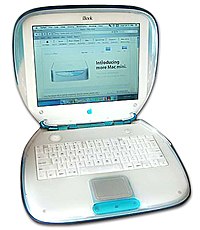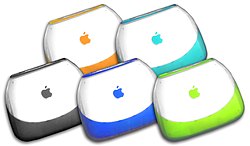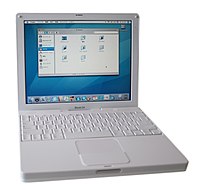IBook: Difference between revisions
mNo edit summary |
|||
| Line 82: | Line 82: | ||
*iBook G3 Dual USB ([[May 1]], [[2001]]) – Second Generation iBook G3 |
*iBook G3 Dual USB ([[May 1]], [[2001]]) – Second Generation iBook G3 |
||
**Sub Par Logic Board Included |
**Sub Par Logic Board Included |
||
12.1-inch Active-matrix TFT Display (1024x768 max resolution) |
**12.1-inch Active-matrix TFT Display (1024x768 max resolution) |
||
**PowerPC G3 500 MHz |
**PowerPC G3 500 MHz |
||
**256 KB L2 cache |
**256 KB L2 cache |
||
Revision as of 20:12, 7 September 2007

The iBook G3 is a now discontinued line of laptop computers that was developed and sold by Apple Inc. between 1999 and 2006. It was targeted at the consumer and education markets, with fewer features and lower prices than the PowerBook, and more recently, the MacBook Pro. The MacBook replaced the iBook line in May 2006.
iBook G3 ("Clamshell")
 The original iBook | |
| Developer | Apple Inc. |
|---|---|
| Type | Laptop |
| Release date | July 21, 1999 |
| Discontinued | May 1, 2001 |
| CPU | PowerPC G3, 300–466 MHz |
After much speculation, Steve Jobs unveiled the consumer-targeted iBook G3 laptop computer during the keynote presentation of Macworld Conference & Expo, New York City on July 21, 1999. The design was influenced by Apple's consumer desktop, the iMac, with a large distinctive shape, translucent clear and colored plastics. Its marketing slogan was "iMac to go".[1]
The iBook G3 design catered to children and students. A carrying handle was built into the hinge. Apple demonstrated Phil Schiller, Apple's VP of Marketing, holding the iBook G3 while jumping off a height (onto cushions) to demonstrate its wireless capabilities. Like the iMac, the iBook G3 used a PowerPC G3 CPU, and included no legacy Apple interfaces. USB, Ethernet, modem ports and an optical drive were standard. The ports were placed uncovered along the side, as a cover was thought to be fragile. Similarly, there were no latches. The bottom surface had additional power connectors that allowed multiple iBooks G3s to be easily charged on a custom-made rack. The iBook G3 was the first Mac to use Apple's new "Unified Motherboard Architecture", which reduced the parts count (condensing all of the machine's core features into two chips) and added AGP and Ultra DMA support.
The first iBook G3 was the first mainstream computer ever designed and sold with internal wireless networking. The display bezel contained the wireless antenna, which attached to an optional internal wireless card. Lucent helped in creating this wireless capability and in establishing the industry standard. Apple released the AirPort Wireless Base Station at the same time.
There was heated debate over many things such as the aesthetics, features, weight, performance, and pricing. The iBook G3 was heftier than the PowerBook of the time, with lower specifications. Standard features like PC card slots were absent, as were long rumoured features like touch-screens, and an ultra-long battery life. The iBook was labelled "toilet seat", among other things, due to the distinctive design. Nevertheless, this same distinctive design made the iBook G3 visible in movies and televisions shows.
The iBook G3 was a commercial success. The line continually received processor, memory, hard disk upgrades, and new colors. FireWire and video out were later added.
Models

Top row: "Tangerine" and "Blueberry"
Bottom row: "Graphite", "Indigo" and "Key Lime"
- iBook G3 (July 21,1999) – First iBook (Tangerine, Blueberry)
- 12.1-inch Active-matrix TFT Display (800x600 max resolution)
- PowerPC G3 300 MHz
- 66 MHz bus
- 32 MB RAM (soldered to logic board)
- Expandable to 544 MB (288 MB specified by Apple)
- 3 GB Hard Disk (ATA-33 Controller)
- CD-ROM
- USB, Ethernet
- Airport (802.11b, optional)
- Mac OS 8.6
- iBook G3 SE (February 16, 2000) – Minor addition to existing line (Graphite)
- 366 MHz
- 64 MB RAM (soldered to Logic Board)
- Expandable to 576 MB (320 MB specified by Apple)
- Mac OS 9.0.2
- 6 GB Hard disk
- (Other Specifications Same as iBook)
- iBook G3 Firewire/SE (September 13, 2000) – Major revision (Graphite, Indigo, Key-lime)
- 12.1-inch Active-matrix TFT Display (800x600 max resolution)
- G3 366/466 MHz
- 64 MB RAM
- 8 MB ATI Rage 128 Mobility AGP 2x
- 10 GB Hard Disk (ATA-66 Controller)
- CD-ROM/4x DVD-ROM
- USB, Firewire, Video Out (through a special 3.5mm cable), Ethernet
- Airport (802.11b, optional)
- Mac OS 9.0.4
- (Other Specifications same as iBook and iBook SE)
The original iBook G3 design was discontinued in May 2001, in favor of the new "Dual USB" iBooks.
Expandability/Upgrades
The original iBook's only customer-serviceable parts were the memory (RAM) and AirPort card, accessed via two slots under the easily-removable keyboard. No other modifications could be performed in warranty, and no PCMCIA port existed to provide additional expansion capabilities. Complicated procedures are required (such as removing nearly 40 screws) in order to access any internal components such as the hard disk and optical drive. Most iBooks shipped with Mac OS 8.6 or 9.0. Support for these iBooks is built into OS X v10.0 through v10.3.9. OS X v10.4 (Tiger) requires a Firewire port and DVD drive, essentially restricting it to the late-model iBook SE.
iBook G3 Dual USB (12.1-inch & 14.1-inch)
 The second-generation iBook G3 (12.1"). | |
| Developer | Apple Computer |
|---|---|
| Type | Laptop |
| Release date | May 1, 2001 |
| Discontinued | October 22, 2003 |
| CPU | PowerPC G3, 500–900 MHz |
The next generation iBook G3 debuted at a press conference in Cupertino on May 1, 2001. The machine had been totally redesigned from scratch. This won the coveted award of most unreliable computer in 2002. Bold colors and the radical form-factor were abandoned for a white and slim-line polycarbonate shell, a design which earned Apple accolades from the computing industry. The handle was removed, as was the latchless design. An L-shaped hinge reduced screen height, a feature Apple adopted in all its future portables.
With the iBook G3, Apple began its use of translucent and white polycarbonate in most of its consumer machines such as iMac, eMac, Mac Mini, MacBook. In contrast, most of its professional products used an anodized aluminum finish, but most of its products also work alot better also
Models
- iBook G3 Dual USB (May 1, 2001) – Second Generation iBook G3
- Sub Par Logic Board Included
- 12.1-inch Active-matrix TFT Display (1024x768 max resolution)
- PowerPC G3 500 MHz
- 256 KB L2 cache
- 64 or 128 MB RAM
- ATI Rage Mobility 8 MB VRAM
- 10 GB Hard Disk
- CD/CDRW/DVD/Combo
- USB 1.1, Firewire, Video Out, Ethernet
- Airport (802.11b, optional)
- Mac OS 9.1
- 2.2 kg
- iBook G3 Dual USB Late 2001 (October 16, 2001) - Minor revision
- 600 MHz
- 15 GB Hard Disk (most models)
- Mac OS X 10.1
- (Other specifications same as Dual USB)
- iBook G3 14-inch (October 2001) – New model, larger 14-inch display
- 14-inch Active-matrix TFT Display (1024x768 max resolution)
- 512 KB L2 cache
- 256 MB RAM
- (Other specifications same as Dual USB Late 2001)
- iBook G3 Mid 2002 (May 20, 2002) – Minor revision
- 600/700 MHz
- ATI Mobility Radeon 16M VRAM
- Mac OS X 10.1
- (Other specifications same as 14-inch)
- iBook G3 Late 2002 (November 2002) – Minor revision
- 800 MHz
- Casing now opaque and white instead of translucent and magnesium
- ATI Mobility Radeon 32M VRAM
- Mac OS X 10.2 and 9.2.2
- (Other specifications same as 14-inch)
- iBook G3 Early 2003 (April 22, 2003) – Minor revision
- 800/900 MHz
- ATI Mobility Radeon 7500 32M VRAM
- 30 or 40 GB Hard disk
- Mac OS X 10.2
- (Other specifications same as Mid 2002)
iBook G4
 iBook G4 (12") | |
| Developer | Apple Computer |
|---|---|
| Type | Laptop |
| Release date | October 22, 2003 |
| Discontinued | May 16, 2006 |
| CPU | PowerPC G4, 800 MHz–1.42 GHz |
A PowerPC G4 chip, slot-loading optical drives and a solid white case and keyboard were added on October 23, 2003—finally ending Apple’s use of the PowerPC G3 chip. The translucent case finish and magnesium components were replaced with opaque plastics. The iBook G4 is notable for lacking the translucent case finish, transluscent keyboard, magnesium chassis and palm rests, and magnesium display hinge (replaced with a plastic part) of most models of the former iBook G3.
Models
- iBook G4 (October 22, 2003) – Major revision, processor switch
- 12-inch or 14-inch Active-matrix TFT Display (1024x768 max resolution)
- G4 800/933 MHz/1 GHz
- 256 MB RAM
- 30/40/60 GB Hard Disk
- Slot-load Combo (CD-RW/DVD-ROM)
- USB 2.0, Firewire 400, Video Out, Ethernet 10/100
- Airport Extreme (802.11g, optional)
- Mac OS X v10.3 "Panther"
- iBook G4 Early 2004 (April 19, 2004) - Minor revision
- G4 1.0/1.2 GHz
- Slot-load SuperDrive (DVD-R) Built to Order Option
- (Other Specifications Same as iBook G4)

- iBook G4 Late 2004 (October 19, 2004) – Minor revision
- G4 1.2/1.33 GHz
- 30/40/60 GB Hard Disk
- Slot-load Combo (DVD/CD-RW)/SuperDrive (DVD-R/CD-RW)
- AirPort Extreme Standard
- (Other Specifications Same as iBook G4 Early 2004)
- The three models are: M9623LL/A (12-inch, 1.2 GHz, combo drive), M9627LL/A (14-inch, 1.33 GHz, combo drive), M9628LL/A (14-inch, 1.33 GHz, super drive)
- Originally shipped with Mac OS X v10.3 Panther but with the release of Mac OS X v10.4 Tiger, all iBooks were shipped with the more up-to-date operating system.
- iBook G4 Mid 2005 (July 26, 2005 to May 16 2006) – Minor revision and the last PowerPC iBooks
- G4 1.33/1.42 GHz
- M9846LL/A: (Retail $999) 1.33 GHz; 12-inch display; 40 GB hard disk; Slot-Load Combo Drive DVD-ROM/CD-RW
- M9848LL/A: (Retail $1299) 1.42 GHz; 14-inch display; 60 GB hard disk; Slot-Load SuperDrive DVD±RW/CD-RW
- While the 14-inch display is bigger it is the same resolution as the 12-inch.
- Both models now feature: 512 MB memory (expandable to 1.5 GB) at 333 MHz; ATI Mobility Radeon 9550 graphics processor with 32 MB video RAM; Sudden Motion Sensor (parks the hard drive head if the iBook is dropped); scrolling trackpad; Bluetooth 2.0+EDR
- Both have a bus at a 10:1 ratio (133 MHz or 142 MHz).
- (Other Specifications Same as iBook G4 Late 2004)
Expandability and upgrades
The iBook keyboard lifts up allowing installation of the AirPort (wireless) card and additional memory. This gives the keyboard a "spongy" effect, especially in PowerPC G3 models with the translucent keyboard. The "spongyness" was reduced in the later PowerPC G4 models.
However, accessing the hard drive is a complex and time-consuming procedure involving partial disassembly of the unit and the removal of over 20 screws, of many different types and length.
Installing memory in the iBook G4 involves removing the keyboard, Airport card and opening the RAM shield with a Phillips 00 screwdriver. While some of the earlier models, e.g. 800 MHz and 933 MHz, have a specified 640 MB RAM limit, it may be possible to have a total of 1.5 GB of RAM installed (512 MB built-in, plus a 1 GB SO-DIMM).
Quality issues
In late November 2003, a number of iBook G3 users started to report a display problem with their laptops. In December 2003, a group of users headed by Michael Johnson at blackcider.com, and Bill Owen at eyestir.com sought to file a class action suit against Apple. In January 2004, in a response to the widely publicised display defect, Apple initiated the "iBook Logic Board Repair Extension Program", which covers any expense of repairing "affected iBooks for three years".[2][3]
New class action lawsuits have been submited December 2006.[4] One discussion forum, guessing that some of the iBook problem was caused by the GPU losing contact, found that placing a shim between the plastic casing and the GPU solved the problem—and that Apple was using this solution also (the video can actually even be reactivated temporarily by squeezing the machine midway between the trackpad and the left of case). For a detailed explanation of the technique for iBook G4 models, see this guide; for the iBook G3, see this guide.
On May 2, 2007, the Danish Consumer Board published an extensive report[5] made by an external party concerning the Apple iBook G4 logic board issue. Also a press release[6] was made, referring to the global consequences this might or will have for possible guarantee claims.
Discontinuation
On May 16, 2006, the Intel-powered MacBook replaced the iBook line.
See also
References
- ^ TidBITS, iBook: An iMac to Go, issue 490 (1999)
- ^ OSnews — iBook Issues? You're Not Alone,[2004-01-03
- ^ Apple.com — Expanded iBook Logic Board Repair Extension Program FAQ
- ^ "Law Suits report in Boston Globe"
- ^ "iBook G4 Logic Board issue report made under the authority of the Danish Consumer Board"
- ^ "Press release about the iBook G4 logic board issue made by the Danish Consumer Board"
